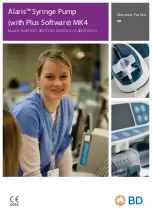
BDDF00001 Issue 5
11/56
Alaris™ Syringe Pumps
Operating Precautions
Operating Precautions
Disposable Syringes and Extension Sets
m
• The Pump has been calibrated for use with single-use disposable syringes . To best ensure correct and
accurate operation, only use 3 piece Luer lock versions of the syringe make specified on the Pump or
described in this manual . Use of non-specified syringes or extension sets may impair the operation of the
Pump and the accuracy of the infusion .
n
• Uncontrolled flow or syphoning may result if the syringe is located incorrectly in the Pump, or if it is
removed from the Pump before the extension set is properly isolated from the patient . Isolation may
include closing a tap in the patient line or activating a flow stop clamp .
• The user must be thoroughly familiar with instructions in this Directions For Use and understand how to
load and confirm the syringe on the Pump . Incorrect syringe loading may result in misidentification of the
syringe type and size leading to significant under or over infusion .
• Secure the extension set to the Pump using the extension set hook at the rear of the Pump . This provides
protection against accidental dislodging of the syringe from the Pump .
• When combining several apparatus and/or instruments with extension sets and other tubing, for example
via a 3-way tap, the performance of the Pump may be impacted and should be monitored closely .
• Always clamp or otherwise isolate the patient line before unclamping or removing a syringe from the
Pump . Failure to do so may result in unintended administration .
Mounting the Pump
• When more than one pump is being used on a patient, those containing high risk, critical medications
must be positioned as close to the patient's heart level as possible to avoid the risk of variations in flow or
siphoning .
• Raising a Pump whilst infusing may result in a bolus of the infusate, whereas lowering a Pump whilst
infusing may result in a delay in the infusion (an underinfusion) .
I
• Do not mount the Pump in a vertical position with the syringe pointing upwards as this could lead to
an infusion of air which may be in the syringe . To protect against the introduction of air the user should
regularly monitor the progress of the infusion, syringe, extension line and patient connections and follow
the priming procedure specified herein .
Operating Environment
• Intended environments include general wards, critical and intensive care, operating rooms, accident
and emergency rooms . The Pump may be used in an ambulance environment . Ensure that the Pump
is appropriately attached using the provided pole clamp . The Pump is designed to withstand possible
bumps and vibrations whilst being used in an ambulance, complying with the standard EN 1789 . If
the Pump is dropped or experiences any severe physical disturbances, arrange a thorough inspection
by appropriately trained technical personnel as soon as is practically possible . The Pump may also be
used outside the ambulance as long as the temperature is within the specified range as stated in the
'Specifications' section and on the Pump label .
• When using any infusion pump in conjunction with other pumps or devices requiring vascular access,
extra care is necessary . Adverse delivery of medication or fluids can be caused by the substantial variation
in pressures created within the infusion system by such pumps . Typical examples of those pumps are
used during dialysis, bypass or cardiac assist applications .
• The pump is suitable for use in hospital and clinical environments other than domestic establishments
that have access to single phase AC power supply .
• The Pump is not intended to be used in the presence of a flammable anaesthetic mixture with air or
oxygen or nitrous oxide .













































